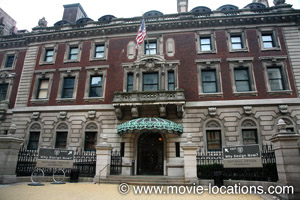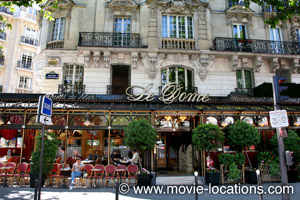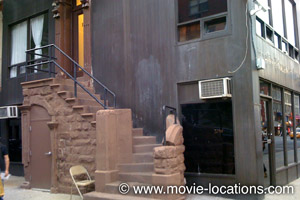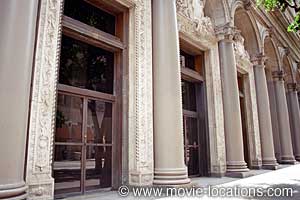Marathon Man | 1976


- Locations |
- New York;
- Paris, France;
- Los Angeles, California
- DIRECTOR |
- John Schlesinger

John Schlesinger’s beautifully-crafted – if confusing – thriller is set in New York, and Paris, though a little Los Angeles is sneaked in.
Nerdy student – and runner – ‘Babe’Levy (Dustin Hoffman) is studying at New York’s Columbia University, up between 116th and 120th Streets in Morningside Heights (familiar from movies such as Ghostbusters, Spider-Man and Altered States).
He trains on the 1.6 mile jogging path which surrounds the Reservoir in New York’s Central Park, between 86th and 96th Streets.
Over on the Upper East Side, the brother of Nazi-in-hiding, Dr Szell, is killed in a tanker conflagration on East 91st Street, outside the Carnegie Mansion, 22 East 91st Street at Fifth Avenue. The mansion itself is a familiar location, seen in films such as the original 1981 Arthur and Working Girl, and now houses the Cooper-Hewitt National Design Museum
The accident seems to be witnessed by worshippers at the Park Avenue Synagogue, though this stands a few blocks south at 50 East 87th Street.

Meanwhile in Paris, Babe’s mysterious brother, Doc (Roy Scheider) stops off in the middle of a traffic jam on Place Vendôme to buy (presumably expensive) chocolates.
He’s on his way to visit a shady antique dealer in the old flea-market in Saint Ouen, way to the north of the city at Porte de Clignancourt.

Dropped off outside Le Soleil, 109 avenue Michelet, Doc strolls along rue Biron to deliver a package to LeClerc at his store, 55-56 rue Biron. It’s back on avenue Michelet that Doc narrowly avoids being blown up by the bomb in a pram.

It’s in one of Paris’s best seafood restaurants, Le Dôme Café, 108 boulevard du Montparnasse, in the 14th arrondissement, that Doc meets up with his superior Janeway (William Devane) to voice concerns about his safety. Did you spot the subtle gay subplot? Listen to Doc’s phone call from his Paris hotel.

Doc wanders through the vast elaborate lobby of the Paris opera house, Palais Garnier, Place de l’Opéra on his way to the meeting with LeClerc (whom he finds bloodily murdered in one of the boxes). You can see the same lavish interior as the Parisian hotel in Neil Jordan's Interview With The Vampire.
Spooked, he warns off his next contact in the Colonnade of the Jardin du Palais Royal (Métro: Palais-Royale), used for another nighttime assignation in Charade.

News of his brother’s death reaches Szell himself (Laurence Olivier), who’s hiding out in a ‘Uruguayan’ jungle lair – which is the trusty old Los Angeles State and County Arboretum, 301 North Baldwin Avenue (again, seen in plenty of films, including Anaconda and Bridesmaids).
Staying on the West Coast, although Babe is studying at Columbia University, the library where he gets to meet Elsa Opel (Marthe Keller) is the Doheny Library, on the campus of the University of Southern California in Los Angeles. Coincidentally, USC previously stood in for the campus of ‘Berkeley’ in Hoffman’s debut, The Graduate.

Elsa’s New York apartment, to which Babe follows her with the book, if you believe the street sign in the movie, is up on ‘94th Street’. In fact, you’ll find its distinctive staircase on the corner of 76th Street and Lexington Avenue on the West Side. The corner has been modernised a little but thankfully the rusticated steps have been left alone.
Babe and Elsa get cosy on a bench alongside Bow Bridge in Central Park, before being attacked by a pair of suspiciously well-dressed muggers, and get cleaned up at the Bethesda Fountain, a famed landmark you can see in loads of films.

There’s another fountain, as Doc has a clandestine meeting with Szell – but you’ll find this one in Los Angeles. The illuminated ‘red steps’ fountain in front of which Doc gets stabbed is in Arco Plaza, 505 South Flower Street at West 5th Street in downtown Los Angeles.
The warehouse where dentist Szell excruciatingly tortures Babe is on New York’s Lower East Side (the car chase roars around the corner of. Carmine’s Bar, 140 Beekman Street at Front Street).
Babe manages to escape onto the north ramp of the Brooklyn Bridge before leaping down onto the road to Federal Plaza, in a complex sequence which took nine nights to film).
The, apparently, safe house in the country, which turns out to belong to Szell’s brother, is on Ward Pound Ridge Reservation, Cross River, a 4,700-acre park and wildlife sanctuary in Westchester County, New York State.
Szell gets an understandable panic attack in the overwhelmingly Jewish Diamond District, 47th Street between Fifth and Sixth Avenues. The trade here grew up in the Thirties when dealers, fleeing Nazi persecution in European diamond centres such as Amsterdam and Antwerp, took advantage of an area that provided both low rent and proximity to the monied customers of Fifth Avenue.
Szell finally flips in the shop at 36-42 47th Street, before being recognised by the shop assistant in 26, who gets savagely despatched outside the 47th Street Subway Station.

Before you get comfortable with the idea that we’re now staying in New York, the bank at ‘58th and Madison’, where Szell is entranced by his diamond cache, is 650 Spring Street, once again in downtown Los Angeles (seen in loads of films, as diverse as Se7en, Spider-Man 2 – and Bridesmaids again).

Outside the bank, on Spring Street, Szell is confronted by Babe, who smartly marches him off to New York, to the Delacorte Clock at the gates of Central Park Zoo before the final confrontation, which is staged at the North Gate House of the Reservoir in Central Park.
Don’t bother trying to peek inside, though. The interior is nothing like as dramatic as it appears in the film. The elaborate ironwork grid above the water is a studio set, built by designer Richard MacDonald deliberately to resemble the layout of an Elizabethan stage.





